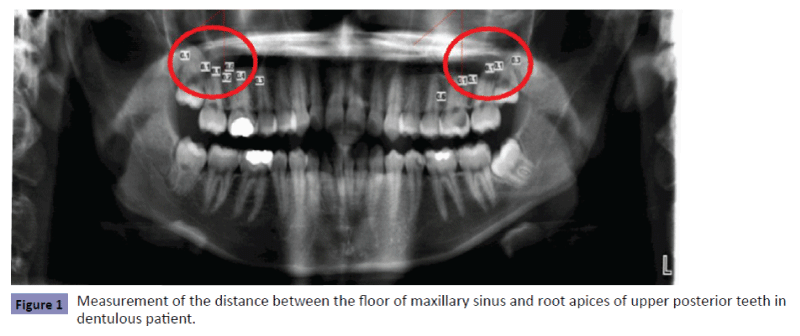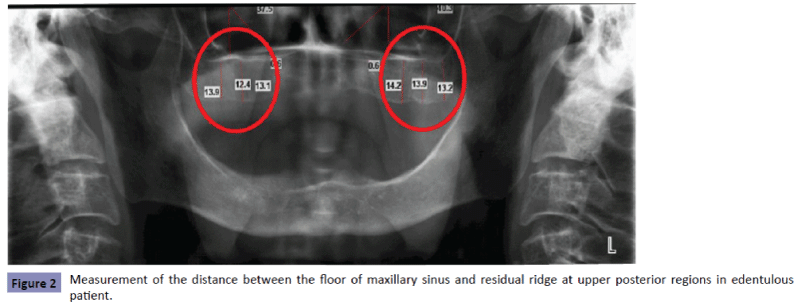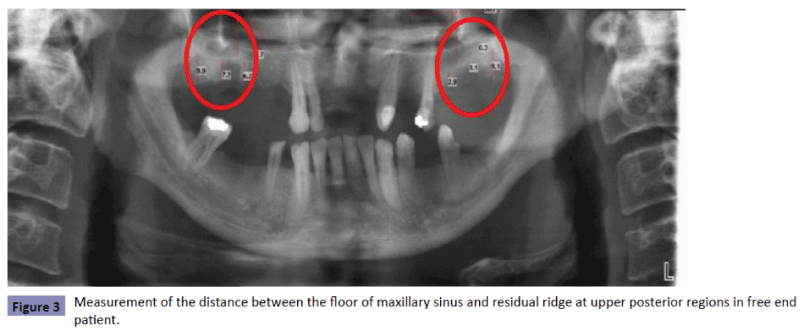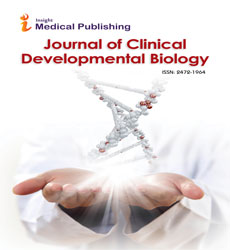Assessment of the Level of Maxillary Sinus Floor in Dentulous, Edentulous and Free End Cases on a Sample of Malay Population Using Orthopantomogram
Imad M. Al-Ani
DOI10.4172/2472-1964.1000009
Belqees A. Allaw1,Imad M. Al-Ani1*,Nazih S. Mustafa2 and Muhannad A. Kashmoola3
1Department of Basic Medical Science, Kulliyyah of Medicine, International Islamic University Malaysia, Kuantan, Pahang, Malaysia
2Department of Oral Surgery, Kulliyyah of Dentistry, International Islamic University Malaysia, Kuantan, Pahang, Malaysia
3Department of Oral Pathology, Kulliyyah of Dentistry, International Islamic University Malaysia, Kuantan, Pahang, Malaysia
- *Corresponding Author:
- Imad M. Al-Ani
Department of Basic Medical Science, International Islamic University Malaysia, Kuantan, Pahang, Malaysia
Tel: 60179776014
Email: imad_alani@yahoo.co
Received date: April 27, 2016; Accepted date: May 10, 2016; Published date: May 13, 2016
Citation: Allaw BA, Al-Ani IM, Mustafa NS, et al. Assessment of the Level of Maxillary Sinus Floor in Dentulous, Edentulous and Free End Cases on a Sample of Malay Population Using Orthopantomogram. J Clin Dev Biol. 2016, 1:2.
Abstract
Introduction: Knowledge about the relation between the floor of the maxillary sinus and the teeth\area considered an important and essential for dental practitioners for the planning of many surgical procedures in this area.
Objective: The purpose of this study was to assess the level of maxillary sinus floor in dentulous, edentulous and free end cases among Malay population based on gender, and age by using panoramic radiographs.
Methods: Sample size was 364 cases including 118 dentulous, 192 edentulous, and 54 free ends. Measuring the distance between maxillary sinus floor and either root apices of upper posterior teeth or residual ridge in dentulous cases, edentulous and free end cases, and study the relation of this distance with gender and age.
Results: The distance in dentulous have no relation to the age and gender and vice versa in edentulous and free end cases.
Conclusion: The distance not affected by age and gender in dentulous cases, while it is effective in edentulous and free end cases.
Keywords
Dentulous; Edentulous; Distance; Edentulous; Maxillary sinus; Orthopantomogram
Introduction
The maxillary sinus is the largest and the first paranasal sinus to develop around the 3rd month of intrauterine life [1]. They enlarge with the facial growth to occupy the space between the posterior maxillary teeth and the floor of the orbits and consist of two spaces, which is air-filled cavity lined with mucosa, mucosal epithelium and lamina propria [2]. In adult, it has a complex pyramidal shape cavity, the floor of maxillary sinus spreads between the neighbouring teeth or between individual roots creating hillocks or protrusions of root apices into the sinus, the roots of the maxillary first and second molars are in intimate relation to the floor of the maxillary sinus in most cases [3,4]. The topography of the inferior wall with the maxillary root apices differs according to an individual’s age, size and degree of pneumatization of the maxillary sinus and the state of dental retention, Accordingly, knowledge of the topography between the root apex and the inferior wall of the maxillary sinus is important for diagnosing and planning dental implantation, endodontic procedures, and orthodontic treatment [5,6,7]. Maxillary edentulism is a pathological condition where the progressive resorption of the alveolar ridge reduces the bone to a thickness of less than 1 mm. Several causes contribute to this phenomenon are metabolic factors, inflammation, hormonal imbalances, and certain systemic pathologies can lead to the bone resorption [8]. As a result of sinus expansion, bone quantity in the maxillary posterior edentulous area may be insufficient for dental implant placement because of the presence of the maxillary sinus which makes the maxillary sinus floor be the danger zone for the oral implantology [9,10]. The rate and degree of the pneumatization process after tooth loss may be influenced by the protrusion of tooth roots into the sinus cavity and molar extraction [11]. The relationship between the root apex and the inferior wall of the maxillary sinus are crucial for diagnosing and treating sinus pathology as well as in assisting in dental implantation. Accordingly, knowledge of the topography of the root apex and the inferior wall of the maxillary sinus is important for diagnosing and planning dental implantation, endodontic procedures, and orthodontic treatment [12]. The present study was conducted to establish the mean distances between the residual ridge and maxillary sinus floor in edentulous and free end cases and dimension between the apices of the upper posterior teeth and maxillary sinus floor in dentulous cases.
Materials and Methods
The collected data period was from Jan 2012 to Jan 2015 and all personal information concerning the patients as well as the diagnostic cause of the OPG was hidden. Each patient was exposed to panoramic X-ray at 64Kv, 7 mA for 19 seconds exposure time and high resolution that used in radiology unit in Faculty of Dentistry (Oral Radiology Unit) to record the OPG of an adult patient. The panoramic X-ray unit that used was Planmeca ProMax (type ProMax 3D, SN: TPX355916, manufactured in Oct- 2010 by Planmeca Oy, 00880 Helsinki, Finland). The sample size of OPG cases was 364 classified to dentulous cases (complete teeth), edentulous (missing all teeth). Moreover, the free end (missing posterior teeth on both sides). Based on age, The cases were classified into six age groups: group 1 (20-29), group 2 (30- 39), group 3 (40-49), group 4 (50-59), group 5 (60-69), group 6 (70-79), the mean age in dentulous 26 years, edentulous 57 years, free end 58 years. The cases were classified based on gender to 104 males and 260 females. The cases which have bone pathology and history of trauma or surgery in the face were excluded from this study.
The measurement was done by using a software program (Planmeca Romix version 27.2) of Faculty of Dentistry, IIUM, Malaysia. Measuring the distance between floor of maxillary sinus and root apices of upper posterior teeth which are Mesiobuccal root (MB), Distobuccal root (DB) and Palatal root (P) for each tooth (mm) (Figure 1), and measuring the distance between floor of maxillary sinus and residual alveolar ridge at three molar regions on both sides of edentulous and free end cases (mm) (Figures 2 and 3). The data was analyzed using Statistical Package for the Social Sciences IBM SPSS software, version 21.0. Data was expressed as mean ± SD. Comparison of the data was done using one-way Analysis Of Variance (ANOVA). Statistically significant level was taken to be p-value less than 0.05.
Results
The measurement of the distance between the floor of the maxillary sinus and root apices of upper posterior teeth is not significantly different between males and females in dentulous (Table 1).
| Tooth | Root | Gender | n | Mean ± SD | Mean Diff | P-value |
|---|---|---|---|---|---|---|
| 1st molar | MB | M | 22 | 0.07 ± 0.23 | 0.02± 0.06 | 0.74 |
| F | 96 | 0.09 ± 0.29 | ||||
| DB | M | 22 | 0.09 ± 0.44 | 0.04± 0.06 | 0.64 | |
| F | 96 | 0.13 ± 0.38 | ||||
| P | M | 22 | 0 ± 0 | 0.07 ± 0.27 | 0.2 | |
| F | 96 | 0.07 ± 0.27 | ||||
| 2nd molar | MB | M | 22 | 0.07 ± 0.22 | 0.04± 0.19 | 0.64 |
| F | 96 | 0.11 ± 0.41 | ||||
| DB | M | 22 | 0.20 ± 0.58 | 0.02± 0.01 | 0.91 | |
| F | 96 | 0.22 ± 0.59 | ||||
| P | M | 22 | 0.15 ± 0.44 | 0.03± 0.09 | 0.72 | |
| F | 96 | 0.12 ± 0.35 | ||||
| 3rd molar | MB | M | 22 | 0 ± 0 | 0.25± 0.87 | 0.17 |
| F | 96 | 0.25 ± 0.87 | ||||
| DB | M | 22 | 0±0 | 0.24± 0.83 | 0.17 | |
| F | 96 | 0.24 ± 0.83 | ||||
| P | M | 22 | 0 ± 0 | 0.20± 0.76 | 0.20 | |
| F | 96 | 0.20 ± 0.76 |
MB: Mesiobuccal Root; DB: Distobuccal Root; P: Palatal Root; M: Male; F: Female; n: Number. Values are expressed as mean ± SD.
Table 1: The distance between maxillary sinus floor and upper posterior teeth related to the gender in dentulous cases.
The distance between maxillary sinus floor and the residual ridge at 1st, 2nd and 3rd molar areas show significant differences between males and females in edentulous and free end cases (Table 2). The study reports that distance in males are less than in females.
| Variable | Gender | Edentulous | Free end | ||||
|---|---|---|---|---|---|---|---|
| n | Mean(SD) | P-value | n | Mean(SD) | P-value | ||
| 1st M | M | 62 | 4.53 ± 3.94 | 0.02* | 20 | 2.46 ± 1.74 | 0.004* |
| F | 130 | 5.91 ± 3.73 | 34 | 5.59 ± 4.38 | |||
| 2nd M | M | 62 | 4.88 ± 3.27 | 0.04* | 20 | 3.78 ± 1.76 | 0.03* |
| F | 130 | 5.86 ± 3.03 | 34 | 5.85 ± 4.00 | |||
| 3rd M | M | 62 | 7.88 ± 3.29 | 0.05* | 20 | 6.90 ± 3.14 | 0.001* |
| F | 130 | 8.75 ± 2.67 | 34 | 10.68 ± 3.78 | |||
1st M, 2nd M and 3rd M are referred to the missing teeth of upper posterior area. n: number. Values are expressed as mean ± SD. *Indicates values are statistically significant difference.
Table 2: The distance between maxillary sinus floor and residual ridge in edentulous and free end cases in relation to gender.
The distance between maxillary sinus floor and residual ridge shows significant differences at 1st, 2nd and 3rd molar areas at age group 3, 4, 5 and age group 6 in edentulous and free end cases (Table 3). No significant differences were observed in the distance between upper posterior teeth and floor of the maxillary sinus in age groups 1, group 2 and group 4 (Table 4). However, group 3 in this part of the study was not included as the cases have missed one or two molar teeth on both sides.
| Cases | Edentulous | Free end | ||||
|---|---|---|---|---|---|---|
| Molar areas | 1st M | 2nd M | 3rd M | 1st M | 2nd M | 3rd M |
| Age group 3 | 4.09 ± 3.90 | 6.05 ± 3.56 | 9.69 ± 3.28 | 8.36 ± 5.90 | 8.04 ± 5.95 | 11.38 ± 4.74 |
| Age group 4 | 5.27 ± 3.66 | 4.92 ± 2.72 | 8.15 ± 2.55 | 4.70 ± 2.78 | 5.14 ± 2.57 | 9.99 ± 4.13 |
| Age group 5 | 5.08 ± 3.47 | 5.33 ± 2.81 | 8.22 ± 2.82 | 2.45 ± 2.19 | 4.24 ± 1.58 | 7.46 ± 3.17 |
| Age group 6 | 8.16 ± 5.10 | 8.46 ± 4.10 | 9.96 ± 3.76 | 2.25 ± 1.96 | 2.71 ± 1.17 | 7.91 ± 2.18 |
| P- value | 0.01* | 0.000* | 0.03* | 0.001* | 0.005* | 0.05* |
1st M, 2nd M and 3rd M are referred to the missing teeth of upper posterior region. Group 3 (40-49), Group 4 (50-59), Group 5 (60-69), and Group 6 (70-79). Values are expressed as mean ± SD. *Indicates values are statistically significant difference.
Table 3: The distance between maxillary sinus floor and residual ridge in free end cases in relation to the age.
| Tooth | Root | n | Group 1 | n | Group 2 | n | Group 4 | Total | P-value |
|---|---|---|---|---|---|---|---|---|---|
| 1st molar | MB | 104 | 010 ± 0.29 | 12 | 0.01 ± 0.05 | 2 | 0 ± 0 | 0.09 ± 0.27 | 0.44 |
| DB | 104 | 0.14 ± 0.42 | 12 | 0.01 ± 0.06 | 2 | 0 ± 0 | 0.13 ± 0.39 | 0.5 | |
| P | 104 | 0.07 ± 0.26 | 12 | 0 ± 0 | 2 | 0 ± 0 | 0.06 ± 0.25 | 0.53 | |
| 2nd molar | MB | 104 | 0.1 ± 0.38 | 12 | 0.11 ± 0.40 | 2 | 0.30 ± 0.14 | 0.10 ± 0.38 | 0.74 |
| DB | 104 | 0.23 ± 0.62 | 12 | 0.07 ± 0.26 | 2 | 0.30 ± 0.42 | 0.21 ± 0.59 | 0.67 | |
| P | 104 | 0.13 ± 0.39 | 12 | 0.06 ± 0.23 | 2 | 0.25 ± 0.07 | 0.12 ± 0.37 | 0.75 | |
| 3rd molar | MB | 104 | 0.23 ± 0.84 | 12 | 0.04 ± 0.14 | 2 | 0 ± 0 | 0.21 ± 0.79 | 0.7 |
| DB | 104 | 0.22 ± 0.8 | 12 | 0.04 ± 0.14 | 2 | 0 ± 0 | 0.19 ± 0.75 | 0.68 | |
| P | 104 | 0.181 ± 0.73 | 12 | 0.03 ± 0.11 | 2 | 0 ± 0 | 0.17 ± 0.69 | 0.73 |
MB: Mesiobuccal Root; DB: Distobuccal Root; P: Palatal Root; n: Number; Group 1 (20-29) year, group 2 (30-39) years, group 4 (50-59) years. Values are expressed as mean ± SD.
Table 4: The distance between the floor of the maxillary sinus and apices of the upper posterior teeth in relation to the age in dentulous cases.
Discussion
This study demonstrated no significant differences in the distance between maxillary sinus floor and apices of upper posterior teeth between males and females in dentulous. Similar observation was noted when measured the distance in both genders by using spiral CT, OPG, and CBCT on different population [5,13,14]. The results of this study show that aging has no effect on the distance between the floor of the maxillary sinus and root apices of maxillary posterior teeth. In this framework, results suggest that the teeth represent a good support for maintaining the bone of the floor of the sinus in its level. These findings of the current study may be related to the fact that the growth of the maxillary sinus continues until the 3rd decade in males and the 2nd decade in females [1].
The present study shows a significant reduction in the distance between maxillary sinus floor and residual ridge in edentulous males than females; this might be related to the higher resorption of the bone on the sides of maxillary residual ridge in males among Malay population, and to the pronounced reduction of the distance after teeth extraction due to periodontitis and the factors such as time of being edentulous as well as the upload pressure of the denture which effect the distance of residual ridge after extraction [15,16,17]. The reduction in calcium absorption may trigger a feedback mechanism via the Parathyroid Hormone (PTH), increasing bone resorption to maintain the calcium balance in the blood [18,19]. Another previous study coincides with this result which observed the reduction was more pronounced in males than in females [20]. Otherwise, another studies reported the reduction was significantly more in females than males [13,21].
The present study has demonstrated a decrement in distance between maxillary sinus floor and residual ridge with aging; this coincides with previous studies and might be related to the increased bone porosity that makes cortical bone becomes more brittle and weaker with aging [17,22,23]. Further studies are in progress to measure this distance in dentulous, edentulous and free end cases with large sample size and including all races (Malay, Chinese, and Indian) by using CT scan and compare the accuracy of these results with OPG.
Conclusion
It is concluded that age and gender have no relation to the distance in dentulous cases while in edentulous and free end cases the distance showed significant differences with age and gender and the reduction are more pronounced in males than females.
Acknowledgment
The authors are grateful to Dr. Patrick Lim for his extensive assistance with the statistical portion of this study.
References
- Jun BC, Song SW, Park CS, Lee DH, Cho KJ, et al. (2005) The analysis of maxillary sinus aeration according to aging process; volume assessment by 3-dimensional reconstruction by high- resolutional CT scanning. Otolarngology and Head and Neck Surgery 132: 492-434.
- Masri AM, Yusof A, Hassan R (2013) A Three Dimensional Computed Tomography (3D-CT): A Study of Maxillary Sinus in Malays. Canadian Journal of Basic and Applied Sciences 1: 25-134
- Bhalajhi S (2009) Dental Anatomy Histology and Development (2nd edn.) Arya (medi) publishing house, New Delhi.
- Norton NS(2011) Netter’s Head and Neck Anatomy for Dentistry. Elsevier Health Sciences.
- Kilic C, Kamburoglu K, Yuksel SP, Ozen T (2010) An Assessment of the Relationship between the Maxillary Sinus Floor and the Maxillary Posterior Teeth Root Tips Using Dental Cone-beam Computerized Tomography. European Journal of Dentistry 4: 462-467.
- Didilescu A, Rusu M, Mihai S, Georgescu C, Ciuluvic R (2012) Morphometric analysis of the relationships between the maxillary first molar and maxillary sinus floor. Open Journal of Stomatology 2:352-357.
- Shakhawan M, FalahA, Kawa A (2012) The Relation of Maxillary Posterior Teeth Roots to the Maxillary Sinus Floor Using Panoramic and Computed Tomography Imaging in a Sample of Kurdish People Key words. Tikrit Journal for Dental Sciences 1: 81-88.
- Testori T (2011) Maxillary sinus surgery: Anatomy and advanced diagnostic imaging. Journal of Implant and Reconstructive Dentistry 3: 18-25
- Ahlam AF (2007) Utilization of Orthopantomograms in Dental Radiology. Medical Dental Journal4: 1-3.
- Nimigean V, Nimigean VR, MÃÆââ¬Å¾ÃâÃâru N, SÃÆââ¬Å¾ÃâÃâlÃÆââ¬Å¾ÃâÃâvÃÆââ¬Å¾ÃâÃâstru DI, BÃÆââ¬Å¾ÃâÃâdiÃÆââ¬Â¦ÃâãÃÆââ¬Å¾ÃâÃâ D, et al. (2008). The maxillary sinus floor in the oral implantology. Romanian Journal of Morphology and Embryology 49: 485-489
- Sharan A, Madjar D (2008) Maxillary Sinus Pneumatization Following Extractions: A Radiographic Study. The International Journal of Oral & Maxillofacial Implants 23: 48-56.
- Ali SH, Nadhim S, Omar O (2012) Evaluation of Proximity of the Floor of the Maxillary Sinus to the Alveolar Bone Crest, Using Digital Panoramic Imaging System, in Erbil City. Zanco Journal of Medical Sciences 16: 106-110.
- SaÃÆââ¬Å¾Ãâà ¸lam A (2002) The vertical heights of maxillary and mandibular bones in panoramic radiographs of dentulous and edentulous subjects. Quintessence International 33: 433-438.
- Zainab AH, Lamia H (2013) Assessment of the relationship between maxillary sinus floor and maxillary posterior teeth root apices using spiral CT scan. Journal Bagh College Dentistry 25: 80-86.
- Knezoviê-zlatariê D (2002) Resorptive Changes of Maxillary and Mandibular Bone Structures in Removable Denture Wearers. Acta Stomat Croat 36: 261-265.
- Laith M, Kasiapan S (2009) Residual alveolar ridge resorption in completely edentulous patients influenced by pathophysiologic factors. Dentika Dental Journal 14: 29-36.
- Suo W, GU Z, Ruan H, Guo X, Zhang W, et al. (2011)Measurements of the height and width of residual alveolar crests in low-set maxillary sinus patients with missing upper molar. Shangahai Journal of Stomatology 20: 308-313.
- Peacock M (2010) Calcium metabolism in health and disease. Clinical Journal of American Society of Nephrology 5: 23-30.
- Chin K, Soelaiman IN, Mohamed IN, Ngah W (2012) Serum testosterone, sex hormone-binding globulin and total calcium levels predict the calcaneal speed of sound in men. Clinics 67: 911-916
- Fatima S, Saad W (2010) Radiographic assessment of the level of the floor of maxillary sinus. Journal Bagh College Dentistry 22: 69-73
- Ural C, Bereket C, Sener I, Aktan A, Akpinar Y (2011) Bone height measurement of maxillary and mandibular bones in panoramic radiographs of edentulous patients. Journal of Clinical and Experimental Dentistry 3: 5-9.
- Boskey AL, Coleman R (2010) Aging and bone. Journal of Dental Research 89: 1333-1348.
- Nor FM, Pastor RF, Schutkowski H (2014) Age at death estimation from bone histology in Malaysian males. Medicine, Science, and the Law 54: 203-20 8.
Open Access Journals
- Aquaculture & Veterinary Science
- Chemistry & Chemical Sciences
- Clinical Sciences
- Engineering
- General Science
- Genetics & Molecular Biology
- Health Care & Nursing
- Immunology & Microbiology
- Materials Science
- Mathematics & Physics
- Medical Sciences
- Neurology & Psychiatry
- Oncology & Cancer Science
- Pharmaceutical Sciences



